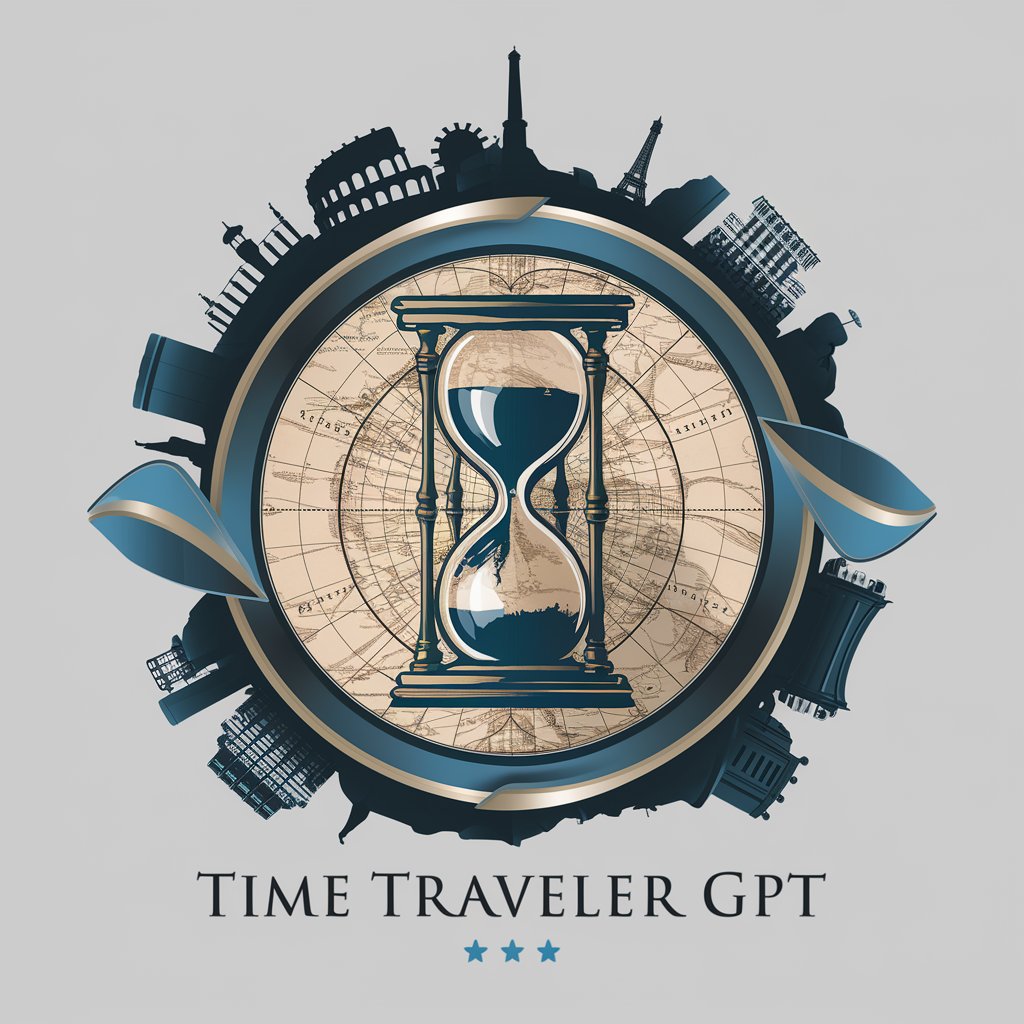Time Traveler - Historical Image Transformation

Welcome! Let's journey through time and explore the past together.
Transforming today's view into history's vision.
Analyze the geographical features in the provided image and identify the location.
Transform the given cityscape into its appearance during the Renaissance period.
Convert this landscape into its ancient historical form, including significant landmarks.
Determine the historical era of this location and describe its transformation over time.
Get Embed Code
Time Traveler: A Portal to the Past through Imagery
Time Traveler is designed to serve as a unique bridge between the present and various historical periods through the medium of images. It specializes in analyzing the geographical and architectural features depicted in photographs and then reimagining those scenes as they might have appeared in selected historical eras. This capability encompasses a wide array of imagery, from natural landscapes to urban settings and historical landmarks. By identifying key elements within a photo, such as architectural styles or natural topography, Time Traveler accurately deduces the location of the photograph. It then employs a deep understanding of historical contexts to transform the image into a version that reflects a chosen time period, such as ancient times, the Middle Ages, the Renaissance, the 18th century, the 19th century, or the early 20th century. This process not only involves the architectural and environmental changes but also considers the evolution of the natural landscape, offering a captivating visual presentation of the past. Powered by ChatGPT-4o。

Key Functions and Real-World Applications
Geographical Identification and Historical Transformation
Example
A user submits a photograph of the Eiffel Tower as seen today. Time Traveler identifies the landmark and offers to reimagine it during its construction in the late 19th century, complete with the surrounding Parisian landscape of that era.
Scenario
This function is ideal for educators and students who wish to visually explore the historical evolution of significant landmarks or for tourists who want to see how their travel destinations looked in the past.
Natural Landscape Evolution
Example
A user provides an image of a modern-day forested area known for its historical significance. Time Traveler analyzes the geography and transforms it to show its appearance before urban development, revealing a more pristine, possibly untouched landscape.
Scenario
Environmental researchers and historians can use this to understand the impact of human development on natural landscapes over time, aiding in studies of environmental degradation or conservation efforts.
Urban Development Visualization
Example
An image of a contemporary city street is transformed into a bustling urban scene from the early 20th century, showcasing the architectural styles, vehicles, and fashion of the period.
Scenario
This is particularly useful for urban planners, architects, and historians who are interested in the evolution of city planning and architectural styles over centuries.
Who Benefits from Time Traveler?
Educators and Students
These users can greatly benefit from Time Traveler's capabilities to bring history to life, offering a visually engaging way to understand and teach historical changes in geography, architecture, and urban development.
Historians and Researchers
Individuals in these fields can use Time Traveler to visualize historical sites, landscapes, or urban areas as part of their research, providing insights into environmental and architectural evolution over time.
Tourists and Travel Enthusiasts
People who love to explore new places can use Time Traveler to see how their destinations looked in the past, adding a layer of historical depth to their travel experiences.
Urban Planners and Architects
Professionals in these fields can utilize Time Traveler to study historical urban layouts and architectural styles, aiding in the design of projects that may seek to preserve or reflect historical aesthetics.

How to Use Time Traveler
Start Your Journey
Visit yeschat.ai for a complimentary experience without the need to sign up or subscribe to ChatGPT Plus.
Choose Your Era
Select a historical period of interest, such as Ancient Times, Middle Ages, Renaissance, 18th Century, 19th Century, or early 20th Century.
Upload Your Image
Provide a clear image of a location you're curious about. This can be a natural landscape, urban scene, or historic site.
Specify Preferences
If desired, mention specific details you want emphasized in the historical transformation of your image.
Receive Your Time-Travelled Image
Review the transformed image, now depicting your chosen location as it might have appeared in your selected historical period.
Try other advanced and practical GPTs
《骆驼祥子》阅读导师
Dive into 'Rickshaw Boy' with AI-powered character dialogues

Recruit Pro
Streamlining Recruitment with AI

Recruit Master
Empowering Healthcare Recruitment with AI

文章翻译
Empowering communication with AI-driven translation

IMG2TXT prompts for SD image generators
Turn Text into Stunning Visuals

DocSeewhY 4.0
Streamline Medical Decisions with AI

安传东专用GPTs
Empowering insights with AI-driven analysis

Acemoglu
Elevating Academic Pursuits with AI

AI全能提分助手
Empowering Your Study Journey with AI

JS Innovator
Empowering Creativity with AI-Powered Web Development

Natural Farewell
Ending Conversations, Naturally with AI

Natural Magic
Empowering Growth with AI

Frequently Asked Questions About Time Traveler
What kinds of images can Time Traveler transform?
Time Traveler can process and transform images of natural landscapes, urban scenes, and historic sites, tailoring the transformation to a selected historical period.
How accurate is Time Traveler's historical transformation?
The transformations are based on extensive historical research and data, aiming for high accuracy in architectural styles, natural environment changes, and other period-specific details.
Can Time Traveler handle images with modern elements?
Yes, Time Traveler can process images containing modern elements, selectively editing or removing these to create a historically accurate representation of the chosen era.
What if my image is too vague or lacks clear geographical features?
For best results, Time Traveler advises users to provide images with distinct geographical or architectural features and may request clearer images or additional details if necessary.
How do I select the best historical period for my image?
Consider the historical context or significant events related to the location of your image. If unsure, experimenting with different periods can reveal fascinating transformations and insights.
